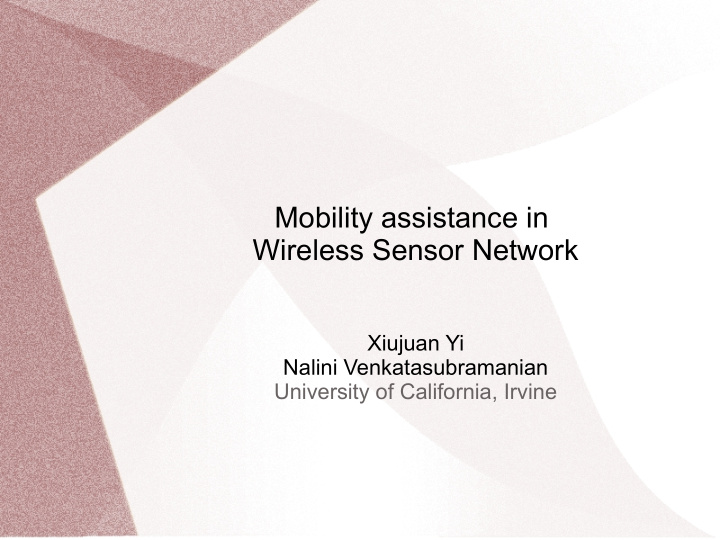



Mobility assistance in Wireless Sensor Network Xiujuan Yi Nalini Venkatasubramanian University of California, Irvine
Outline Background Why people introduce robots into wireless sensor network? Trade-off Advantages & Overheads Challenges What's the problem by employing robots? Solution How to overcome these problems?
Background Energy Concern in Wireless Sensor Network Low-energy design Energy harvesting Hierarchy deployment Abundant deployment Mobility Sparsely deployed sensors
Background Mobile nodes' possible responsibility Sensing Mobile relay(router) Mobile Sink Energy deliverer ......
Tradeoff Advantages flexibility: multi-functional robots hierarchy: sensors could be made simple and inexpensive Overhead long latency large buffer complexity in robots
Mobile Sink-Challenges Schedule of mobile robots Subject to the following requirements, find a set of points, and the times and the sequence to visit them for the robot(s). Minimizing the length of the tour No data overflow No missed deadlines etc.
Solution-Overview Transform such optimization problems to already known problems. Shortest path for the robot(s) TSPN, Mixed-Integer Problem No buffer overflow k-TSPN, Mobile-Element-Schedule others
Solution-Category Random Walking Straight line applicable to uniformly deployed sensor nodes Basic TSP Given a collection of cities and the cost of travel between each pair of them, the traveling salesman problem(TSP) is to find the cheapest way of visiting all of the cities and returning to the starting point. TSPN (TSP with neighborhood) Given a collection of n disjoint regions(neighborhoods), find a shortest tour that visits each region. K-TSPN (multi-robot) k travelers visit n cities, and the objective is to minimize the length of the maximum tour. Periodic VRP with Dynamic Time Windows nodes have dynamic deadline to be visited
Solution-Category[4]
References [1]M. Ma and Y. Yang, “Data gathering in wireless sensor networks with mobile collectors,” IEEE IPDPS , Miami FL, April 2008. [2]B. Yuan, M. Orlowska, and S. Sadiq. On the optimal robot routing problem in wireless sensor networks. IEEE Trans. on Knowl. and Data Eng. , 19(9):1252–1261, 2007. [3]Somasundara, A., Ramamoorthy, A., Srivastava, M.: Mobile Element Scheduling for Ef- ficient Data Collection in Wireless Sensor Networks with Dynamic Deadlines. In: IEEE RTSS. (2004) [4]JIAN MA, CANFENG CHEN AND JYRI P. SALOMAA,mWSN for Large Scale Mobile Sensing, Journal of Signal Processing Systems 51, 195–206, 2008
Recommend
More recommend